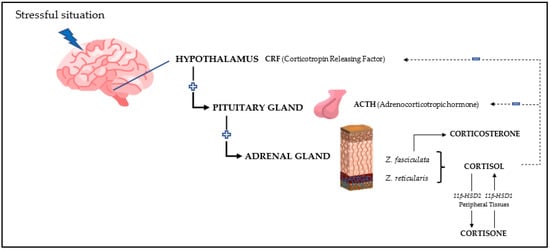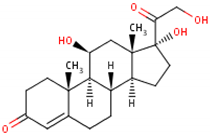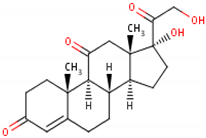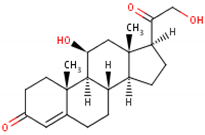The main glucocorticoids involved in the stress response are cortisol and cortisone in most mammals and corticosterone in birds and rodents. Therefore, these analytes are currently the biomarkers more frequently used to evaluate the physiological response to a stressful situation. In addition, “total glucocorticoids”, which refers to the quantification of various glucocorticoids by immunoassays showing cross-reactivity with different types of glucocorticoids or related metabolites, can be measured.
- glucocorticoids
- cortisol
- cortisone
1. Introduction
Glucocorticoid, also known as glucocorticoid (English: glucocorticoid), is an adrenocortical hormone, a steroid hormone secreted by the fascicular zone of the middle layer of the adrenal cortex, which can also be synthesized by chemical methods. Cortisone and cortisol in human body belong to glucocorticoids. Because it can be used for diseases that are not matched by ordinary antibiotics or anti-inflammatory drugs, such as SARS, septicemia, etc., it has the function of regulating the biosynthesis and metabolism of sugar, fat, and protein, and also has the anti-inflammatory effect. It is called "glucocorticoid" because its activity of regulating carbohydrate metabolism is first known by people.

2. General Characteristics of the Main Glucocorticoids
Glucocorticoids are a group of endogenous adrenal hormones with a 21-carbon skeleton that are derived from cholesterol and that are released in a stressful situation. When released, they bind mainly to the corticosteroid-binding globulin (CBG), making them available for use at systemic or tissue level [12][13]. Their function is performed by intracellular binding to glucocorticoid receptors (GRs), which belong to the family of nuclear receptors [13][14]. Although the name “glucocorticoids” originates from their effects on plasma glucose, they are also involved in catabolic metabolism, inflammatory and immune response, and other physiological functions [14][15][15,16]. The main glucocorticoids involved in the stress response are cortisol, cortisone, and corticosterone (Table 1). Their concentrations allow the species to be classified as cortisol-dominant (most mammals) or corticosterone-dominant (such as rats, mice, birds or reptiles). Cortisone is produced mainly in the cortisol-dominant species, and its concentration depends on the activity of the 11β-hydroxysteroid dehydrogenase (11β-HSD) type 2 enzyme, which is expressed mainly in kidney, colon, and salivary glands [13][14].| Cortisol | Cortisone | Corticosterone | |
|---|---|---|---|
| Formula | 11β,17α,21-trihydroxypregn-4-ene-3,20-dione [16][17] 1  |
17-hydroxy-11-dehydrocorticosterone [17][18] 2  |
11β,21-dihydroxypregn-4-ene-3,20-dione [18][19] 3  |
| Structural differences | An extra hydroxyl group attached to the 17th carbon [19][20]. | A ketone group attached to the 17th carbon [20][21]. | No extra hydroxyl group on the 17th carbon [19][20]. |
| Metabolism | Synthesised from pregnenolone in adrenal gland. Inactivated mainly in the kidney by 11β-hydroxysteroid dehydrogenase (11β-HSD) type 2 into cortisone [21][22][22,23]. |
Transformation in the liver, lungs, ovaries, and central nervous system by 11β-HSD type 1 into cortisol [23][24]. | Derived from pregnenolone in adrenal gland [18][19]. |
| Activity | Active molecule [24][25] | Inactive molecule | Active molecule |
| Half-life | In plasma: 66 min In tissues: 12 h [25][26][26,27] |
In plasma: 90 min [20][21] | In plasma: 60–90 min [27][28] |
| Predominant species | It is the main glucocorticoid in most mammals [28][29] | Same species as cortisol | It is the main glucocorticoid in rats, mice, birds, and reptiles, due to a lack of the enzyme 17-α hydroxylase [9] |
3. Measurement
In general, there are two types of assays for the quantification of glucocorticoids:- (1)
-
Those using techniques based on the reaction of an antibody with the analyte to be measured, such as radioimmunoassay (RIA), enzyme immunoassay (EIA), chemiluminescence, and, more recently, bead-based luminescent amplification assays (AlphaLISA). RIA assays are currently used with less frequency due to the need of special facilities and the radioactive nature of some components.
- (2)
-
Techniques based on the direct quantification of the analyte, including high-performance liquid chromatography (HPLC) [34][35][35,36] and liquid chromatography–mass spectrometry (LC-MS/MS) [36][37][37,38], with the latter being the most sensitive [8].Glucocorticoids can be measured in different sample types. Although blood has been traditionally frequently used, the stress that individuals suffer from blood collection [28][29] can interfere with the results. In this line, non-invasive alternatives, such as saliva, hair, faeces, or feathers, are becoming increasingly important [39][58][59][60][40,59,60,61]. There are three main glucocorticoids used to evaluate stress: cortisol, cortisone, and corticosterone, which vary in their amounts in different sample types and animal species. In addition, there is the concept of total steroids, which is used when immunoassays with antibodies showing cross-reactivity with different glucocorticoids or related metabolites are employed, being mostly used in faeces.Table 2.Main methods used for glucocorticoid measurement.
Analyte Analytical Method Reference Cortisol EIA [33][38][39][34,39,40] RIA [40][41][41,42] Chemiluminescence [42][43] AlphaLISA [43][44] HPLC [34][35][35,36] LC-MS/MS [36][37][37,38] Cortisone AlphaLISA [43][44] UHPLC-MS/MS [44][45][45,46] LC-MS/MS [46][47] LC-MS3 [47][48][48,49] Corticosterone EIA [49][50][50,51] RIA [51][52][52,53] Total steroids EIA [53][[5454][,5555],56] RIA [56][57][57,58]
